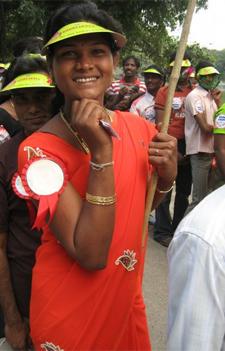
WORLD AIDS DAY IN INDIA. Roughly 2,000 took to the streets of Hyderabad, India on Nov 28, to raise awareness about HIV/AIDS. Credit: Kaj Hasselriis photo
Take a good look at my picture, at the top of this column.
Do I look like a man to you?
I’ve never had any doubt about my male identity. But in India, being gay is associated with being female, at least in many people’s minds.
I discovered this at the very first HIV/AIDS march in Hyderabad, about 700 km southeast of Mumbai. Being the only foreigner in sight, the local media treated me like a VIP and surrounded me for a scrum.
I told them I was a gay man from Canada and said it was terrific to see so many gay Indians marching openly in the streets.
Afterwards, a few straight guys approached me.
“You are a man?” they asked.
“Yes,” I answered. (As if that wasn’t obvious.)
“But how? You are different from us,” they kept saying.
I couldn’t convince them that a person could be gay and male at the same time. As it turns out, this is a common misperception in India.
And if you look at my photos from the march, you can begin to see why.
About 2,000 people participated in the Nov 28 event, which started as a parade and ended as a day of speeches and drag shows in Hyderabad’s gay cruising ground. Most of the participants were bused into the city from nearby towns and villages by HIV/AIDS organizations, in an effort to teach them about safe sex. Though many of the marchers wore colourful masks to hide their identities, they all seemed thrilled to stop traffic for a few blocks.
Unfortunately, I wasn’t able to chat with most of them. They were all lower-class Indians who spoke little or no English. Organizers of the event called them MSM — men who have sex with men — since they don’t all self-identify as gay.
The crowd consisted of five different groups:
- Men who have sex with other men;
- Men who pay other men for sex;
- Men who sell sex to other men;
- Transgendered people who self-identify as female; and
- Hijras, otherwise known as India’s “third sex”, ie. men who have been castrated and then dress and act like women.
The prominence of hijras in Indian culture, combined with the invisibility of homosexuality, helps explain why many people assume that gays and hijras are one and the same — especially when they’re walking together, hand-in-hand.
The confusion surrounding man-on-man sex in India is contributing to the country’s sky-high rate of HIV/AIDS. In the state that includes Hyderabad — Andhra Pradesh — the percentage of men who have sex with men carrying the virus is a shocking 15 percent, the highest rate in the country. In the minds of many people, “male to male is just fun, not sex,” a gay rights leader in Kolkata told me.
(I’ll get to that in Friday’s column.)
But for now, Indians at large are starting to get the message about different sexualities and genders. A lot of the credit goes to the out and proud participants in the parade — people like Bhanu Shankar.
She’s a trans woman from a town that’s so small it’s not even on my Lonely Planet map. Two years ago, Shankar got married to a man in a traditional ceremony officiated by a Hindu priest and attended by 600 onlookers from her community.
She told me that open relationships like hers are “not common.” But she’s not your average Indian trans person, either. “People accept me because of my [positive] attitude and behaviour,” she said. “My parents are cooperating with me.”
For the past four months, Shankar has been taking hormone treatments. Eventually, she dreams of going to a hospital in India’s capital, Delhi, to get a sex-change operation. She’s an image of true self-confidence.
And to those straight guys I met at the parade, I’d like to add: female.
Read Kaj’s previous columns from India:

 Why you can trust Xtra
Why you can trust Xtra


